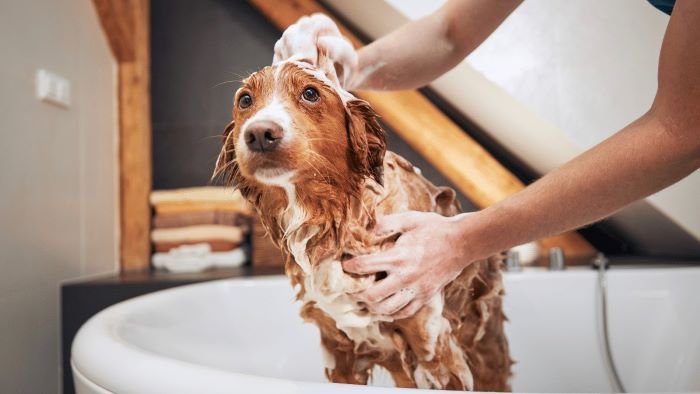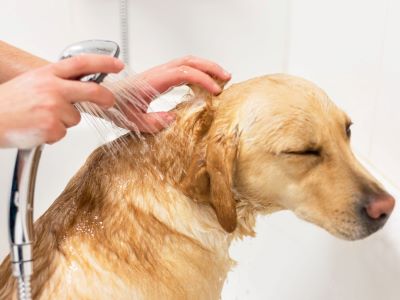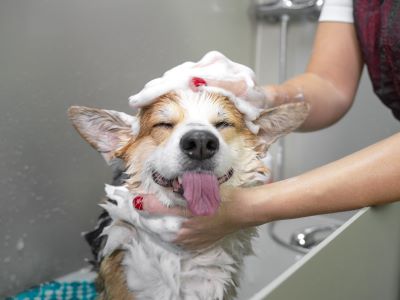Do you love your pet? You do, of course, and giving them a pleasant bath is one of the ways to ensure their health and happiness. But, have you wondered how often you should bathe your dog? Well, there is no universal answer to this curiosity and that makes it a tricky question.

Different dog breeds have different needs and so does the bathing schedule, depending upon various factors; their coat, lifestyle and skin conditions. Let us explore this in detail and find out how often you can enjoy the bathing experience with your canine. And don’t worry, we won’t judge you if you end up getting more wet than your dog. 😉
How Often Should You Bathe Your Dog?
Many pet parents are confused about the bathing schedule of their pups and often ask how often should they bathe their dogs. Well, the answer depends on the breed and lifestyle of their dogs. As a general rule, it is recommended for dogs to bathe once every two or three months.🛁
Before scheduling the bathing routine for your Fiddo, you should ask yourself. Does your dog spend most of his time outdoors or does he have any skin problems? Does he have long hair? If your answer to any of these questions is a yes, then your dog needs more frequent baths.
However, you should not over-bathe your dog. Dogs have natural oil in their coat to prevent their fur from getting damaged.[1] Too frequent baths can wash off the natural oil, damaging the coat. Bathe your dog correctly and properly as recommended by your vet.

On the other hand, you should not bathe your young puppies until the first eight weeks of age. Puppies are not fully developed to regulate their body temperature. They might get overheated or too cold during their baths and hence you should first prepare your puppy for grooming. It is always advisable to avoid giving baths to small pups.🐕
Factors That Affect the Bathing Schedule
According to the University of Florida College of Veterinary Medicine, there are three factors that can be considered while deciding how often to bathe a dog. These are their coat, skin condition and lifestyle. The frequency of bathing depends partly on your dog’s grooming needs. Our guide on how to groom a dog covers this in more detail.

Coat Type
Dogs with medium to long coats should get more frequent baths, around once every four to six weeks, however, other hairless breeds like Labrador Retrievers need to bathe every week. The hairless breed lacks the protection layer around their skin and hence it increases the risk of bacteria absorption and pore blockages.
Dog breeds with short coats like a French Bulldog, can be bathed once in one to three months. The same rule goes for breeds with long and thick coats like Huskies. These breeds often shed their fur, naturally eliminating the dead skin cells, dirt and bacteria from the coat.
Skin Condition
If your dog is having a skin problem or a temporary skin infection then you may consider bathing him on a frequent basis. Generally, veterinarians 👨⚕️ prescribe some special shampoos to such dogs and more frequent baths to cure the skin condition.
Lifestyle
Many dogs are active and love outdoor activities whereas others love being indoors. Active dogs 🏈🥏 will no doubt require more frequent baths, at least once every two weeks. However, if your dog loves to swim, play in the mud or gets dirty through other activities, then he needs a bath every time after playtime.
On the other hand, lazy pooches 😴 might need to bath once every three months depending on their type of coat. Thus, these three factors altogether decide how often should you bathe a dog.
Importance of Regular Baths
Along with exercise and healthy food, maintaining hygiene is important to maintain a pet’s health and well-being.[2] Regular baths can promote a shiny coat and healthy skin. There are many benefits of regular bath which keeps the dog healthy and protects your dog as well as you from allergies.
Regular baths can promote a shiny coat and healthy skin. However, some dog owners may find that their dog still has an odor even after bathing. This leads to the question, why does my dog stink even after a bath?
Shiny Coat
Taking care of your furry friend’s hygiene is essential for their health as well as your happiness. Keeping them free from dirt, fungus, fleas and odours will ensure that you enjoy their company even more.

During winter, it is crucial to add a conditioner to their grooming routine. With the dry and cold air, their skin can get itchy, which is why exfoliating the dead skin and using a conditioner will make both you and your pooch happy.
Reduce Inflammation and Infection
Dirty skin means accumulation of dirt and germs, eventually leading to skin problems. Just like humans, dogs have pores on their skin and over time they get clogged and dirty. This causes various skin diseases.
Therefore, it is crucial to give your dog regular baths so that your dog gets rid of possible infection and inflammation caused due to skin problems.
Reduced Shedding
You must be fed up with your pet’s shedding on your favourite couch, furniture and the floor, but no more! The more often they take a bath, the less they shed. However, this doesn’t mean that you should bathe him every day. Regular baths reduce the shedding of fur since brushing your dog after a bath will help you collect the clumps of hair all at one time, thus leaving a clean house for you.
Regular baths are important for your dog’s health and hygiene, but some dogs tend to go a little crazy after bath time. This phenomenon leads many owners to ask – why do dogs go crazy after a bath?
FAQs
Can I bathe my dog 2 times a week?
The best for your dog might be recommended by your veterinarian or groomer. Never bathe your dog more than once a week unless your veterinarian advises it. Take extra care to notice any lumps, bumps or skin changes on your dog while you’re giving him a bath because they could be signs of a health issue.
How do I know when my dog needs a bath?
It is very easy to recognise the signs of your dog getting dirty. A strong, unpleasant odour or visible dirt on the coat contributes to it. Other signs include excessive shedding, your dog scratching or licking himself more than usual and skin irritation or redness.
Should dog baths be warm or cold?
It is best not to use cold water when bathing your dog. In simple words, cold water simply doesn’t work as well for cleaning. Warmer water thoroughly cleanses the dirt and you’ll have a happier pet if you use warm water.
Can I bathe my 4-month-old puppy twice a week?
It should only be done once every three to four weeks. If your puppy frequently gets dirty by rolling around in mud and grass, you may need to bathe it frequently. Depending on the breed, length of fur, skin issues, and other factors, the frequency of puppy baths can vary.
Should you put coconut oil on your dog?
Just as with people, applying coconut oil to your dog’s skin can help to lubricate the canine’s skin, especially important in the harsh winter months and prevent other signs of irritation. Coconut oil can increase lipid levels on the surface of the skin if your dog already has dry skin or dandruff.
Overview
Bathing your dog can be a fun and rewarding experience for both of you, as long as you do it properly and not too often. Be sure to follow up with a good dog drying towel uk or dog drying bag to gently dry your dog’s coat and skin after the bath.
The best way to find out how often your dog needs a bath is to consult your veterinarian 👨⚕️, who can assess your dog’s individual needs and preferences.You can also observe your dog’s behaviour and appearance, and look for signs of dirtiness, odour, itching or irritation.
Remember to use a mild shampoo designed for dogs and rinse well to avoid leaving any residue. Happy bathing! 🐶🛁
There are many benefits of regular bath which keeps the dog healthy and protects your dog as well as you from allergies. For example, baths help reduce inflammation and infection. This leads some owners to wonder, how long after being neutered can a dog have a bath?
References:
- Pet Hygiene | VMBS News. (2022b, March 11). VMBS by Texas A&M University.
- McDonald, S. E., Sweeney, J., Niestat, L., & Doherty, C. G. (2022). Grooming-Related concerns among companion animals. Frontiers in Veterinary Science.



